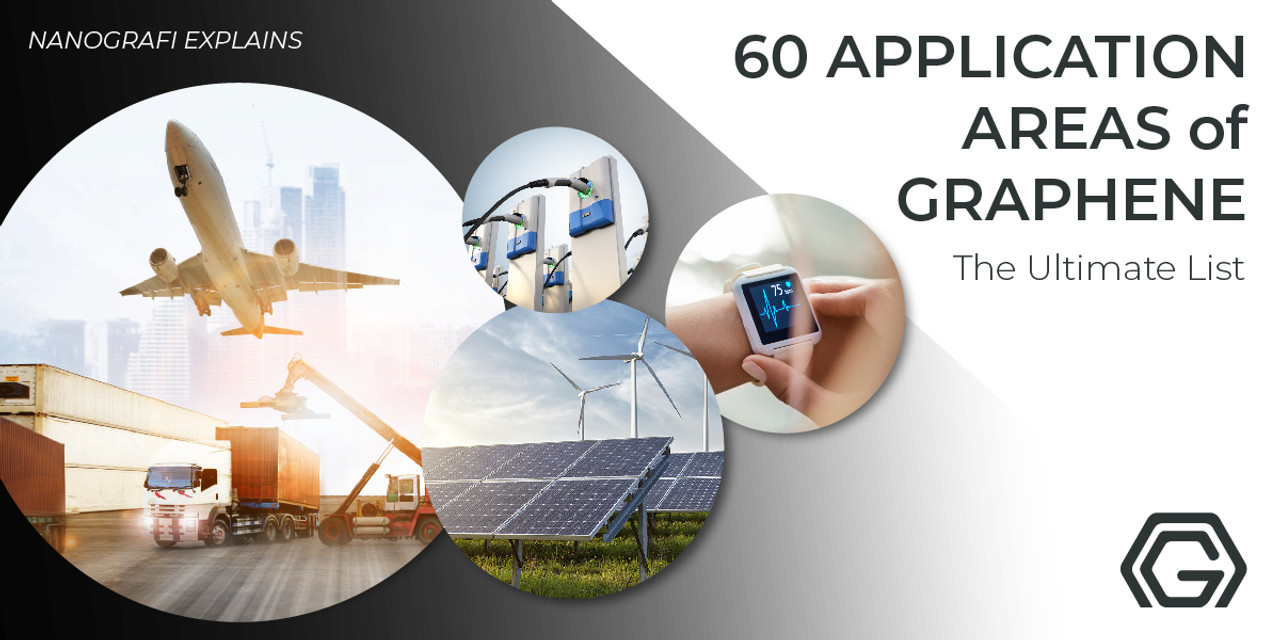Graphene Oxide for Heavy Metal Sensing - Nanografi
The electronic and physical properties of graphene oxide have made it the center of attention for numerous applications such as applying heavy metal sensing in various areas.
The trends have been concentrated on the application of reduced graphene oxide basically obtained from the chemical reduction of exfoliated and oxidized graphite. More specifically, cheaper and simpler processing sheets of graphene oxide are synthesized through oxidation and exfoliation of graphite with no excessive production steps with applications in drug delivery vehicles and hybrid functional materials.
Introduction
In effect, the large specific surface area and strong hydrophilic nature of graphene oxide make it a great potential to remove pollutants from aqueous solutions, especially a broad range of heavy metal ions. With regard to its molecular structure, graphene oxide contains various functional groups such as carboxyl, hydroxyl and epoxy with oxygen atoms in their structure.
Preventing Environmental Pollution
Generally speaking, graphene oxide is not a compound to occur naturally and its chemical structure has been left ambiguous due to its oxygen-rich hygroscopic property and non-stoichiometric functionality. It is somehow a challenging area to remove these oxygen moieties in order to determine the properties of the final product to perfectly resemble graphene. Accordingly, it is essential to find an appropriate reducing agent in order to process the chemical reduction of graphene oxide to obtain a highly qualified graphene product. In this regard, Nanografi presents top-quality graphene solutions and research area for enhanced projects, productions, and technology.
Properties of Graphene Oxide
Considering the chemical structure, graphene oxide is most similar to graphene itself with both having a hexagonal carbon lattice. However, the graphene oxide sheet is generally distorted where it binds to oxygen groups. In fact, graphene oxide is considered the number one source for the large-scale production of graphene over the years with growing applications including the transparent conductor, inorganic photovoltaic cells, and potential materials for an electrode in Lithium-ion batteries. So far, numerous theoretical models have been suggested for the fundamental determination of the graphene oxide structure in the literature with a lot of controversies. The main reasons for all the controversy in the structure of graphene oxide are the sample-to-sample variability of two different synthesis methods, the amount of amorphization, the degree of oxidation, the non-stoichiometric nature of graphene oxide as well as the limited resolution in the employed characterization techniques. Despite all the efforts and the failures in suggesting a comprehensive structural description, the precise determination of graphene is still worth studying since it can considerately improve the understanding of the reduction and functionalization leading to promising outcomes in graphene synthesis and production.
Heavy Metal Ions Hazards
Generally, heavy metals are referred to as transitive metals from the periodic table with relatively high atomic numbers, high atomic weights, and densities. Although some heavy metals such as zinc, cobalt, and iron are essential nutrients along with relatively harmless ruthenium indium and silver, other heavy metals including lead (II) mercury (II), cadmium (II), chromium (III), and arsenic (III) are classified as the most hazardous materials with the necessity to remove them from the environment. In effect, these metals have the greatest potential to cause life-threatening health disorders upon their extensive use and higher doses. The toxicity of these metals and their distribution in the environment have raised a lot of concerns. For instance, hexavalent chromium is categorized as a highly toxic compound similar to many mercury compounds, mercury vapor, and lead. These five metals strongly react with sulfur and in the human body, they engage in reactions with enzymes via thiol functional groups (-SH) that are responsible for controlling the kinetics of metabolic reactions. The consequent metal-sulfur compounds cause the inhibition of appropriate and desired to function of the enzymes that involve in human health and in continuing, these crucial and vital enzymes get deteriorated mostly fatally. In another example, exposure to high levels of lead (II) and its salts could potentially cause anemia, excessive fatigue, and kidney and brain damage and high exposure to them could cause death. Moreover, Pb2+ can go through the placental barrier in pregnant women damaging the nervous system of the baby.
Heavy Metal Sensing Based on Graphene-Oxide
Practically, there are strong contractions between Cu2+ and the surface of graphene oxide to result in an excellent absorbent material in addition to considerable enhancement in the electronic conductivity of the system as a result of metal ions binding to oxygen moieties on the surface of graphene oxide. Similarly, it is possible to add Ca2+ and Mg2+ ions in order to increase the mechanical strength of composites based on graphene oxide.
Electrochemical-Based Graphene Oxide Sensing
Recently, an electrochemical sensor based on graphene oxide has been designed regarding significant characteristics such as good conductivity and high absorption. The graphene oxide in this study, with its density mixed oxygenated crops including epoxide, hydroxyl, and carboxyl, is synthesized from exfoliation and oxidation of pure graphite powders. This electrochemical technique employs cyclic voltammetry that provides preliminary qualitative analysis of gold electrodes modified with graphene oxide for the purpose of absorption of Pb2+, Cu2+ and Hg2+ metal ions in aqueous solutions. In so doing, and prior to the accumulation of heavy metal ions in the solution, no reduction peaks belonging to the cations are recorded in the buffer/electrolyte solution. Nevertheless, after the accumulation of heavy metal ions in the buffer/electrolyte solution, the peaks of the ions are observed at the expected positions supporting the completion of the redox reaction. For quantitative analysis, on the other hand, square-wave voltammetry is adopted using the same electrolyte condition because of its higher sensitivity compared to the cyclic voltammetry technique. Ultra-high sensitivity in this technique based on graphene oxide originates basically from the accumulation of metal ions on the surface of graphene oxide causing Faradaic to a capacitive current ratio.
Fluorescent-Based Graphene Oxide Sensing
In general, carbon-based materials are among the most interesting techniques mostly because of their excellent biocompatibility, stability and lower cytotoxicity. Particularly, graphing possesses tunable fluorescent properties using surface functionalization and the alterations of the size of graphene sheets. Graphene oxide shows visible near-infrared fluorescence because of the small Sp2 carbon encapsulated within the Sp3 matrix. The presence of various oxygenated functional groups on its surface causes an opening in the band gap resulting in a unique luminescence desirable for the detection and determination of hazardous metal ions like Hg2+, Pb2+, and Cd2+ whose serious risks to human health have been fully demonstrated. It is always crucial to explore simple, rapid and sensitive analytical methods in order to monitor these metal ions so precisely in drinking water. In fluorescent-based techniques relying on the optical properties of graphene oxide, some sensing platforms have been designed to effectively remove and detect these hazardous materials using, for example, graphene oxide and gold nanoparticles through fluorescent quenching and restoration responses.
To discover the latest articles in graphene, you can read 60 Uses and Applications of Graphene.
Conclusion
Graphene oxide with its heterogeneous electronic structure coming from the Sp2 and Sp3 bonding and the unique physicochemical structure possesses remarkable electrical and optical properties for water sensor applications. Given the advantages of fluorescence emission and fluorescence quenching and restoration, graphene oxide is a capable and practical sensing platform based on charge transfer and contrast enhancement. Future holds much room for applications based on the exceptional fluorescence ability of graphene oxide to be used in sensing applications and bring detection limit resolution of water sensors to a whole new level much beyond the current state of art.
References
Chang, J., Zhou, G., Christensen, E. R., Heideman, R. & Chen, J. Graphene-based sensors for detection of heavy metals in water: A review Chemosensors and Chemoreception. Anal. Bioanal. Chem.406, 3957–3975 (2014).
Gong, X., Bi, Y., Zhao, Y., Liu, G. & Teoh, W. Y. Graphene oxide-based electrochemical sensor: A platform for ultrasensitive detection of heavy metal ions. RSC Adv.4, 24653–24657 (2014).
Luo, H. A Theoretical Study of Graphene Oxide Chemical Structure. 44 (2017).
Recent Posts
-
Advanced Materials for Unmanned Aerial Vehicle (UAV) Protection Against Laser
Consider a UAV on a critical mission, rendered inoperative by a sudden laser attack. With the increa …26th Jul 2024 -
Simulation and Modeling of Material Properties
Our world is composed of a dazzling array of materials, each with its own unique properties that dic …19th Jul 2024 -
Advanced Coatings for Superior Corrosion and Wear Resistance
Corrosion and wear pose significant challenges across various industries, leading to substantial eco …12th Jul 2024







